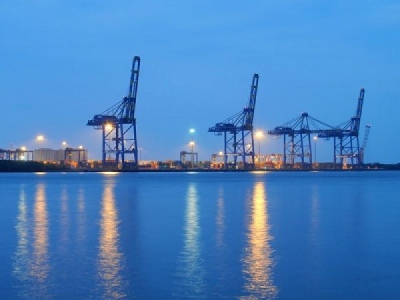
Posted on June 5, 2018
By M.K. Venu and Noor Mohammad, THE WIRE
The Narendra Modi government has relaxed its cabotage policy – a set of rules that govern how goods are shipped within the country, that is from one domestic port to the another – with an eye to making India a trans-shipment hub.
However, data shows and experts say that Indian port tariffs are too high to compete with Sri Lanka and Singapore, the two popular ports that attract bulk of Indian trans-shipment cargo.
Trans-shipment traffic is the cargo that is transported between an Indian port and an international hub port.
The average call cost for vessels of 3,000 TEU (twelve-foot equivalent unit) capacity in India works out to $32,000, compared with $7,000 in Colombo, $8,000 in Singapore and $12,000 in Hong Kong, according to portsrategy.com, a shipping industry news website.
In India, shipping lines are additionally charged for extensive dredging that the government undertakes to make India’s silted coastline approachable, which finally raises the call cost for vessels.
In Mumbai, the cost of dredging the harbour has shot up by 154% in the last decade. The annual dredging cost of the Mundra port run by Adani group is Rs 450 crore.
The annual dredging cost of the Vallarpadam port is Rs 110 crore. The Kerala government has sought a three-year dredging subsidy to make viable the port which is operating at less than half its capacity.
Port handling charges too are on the higher side in India. According to logistics experts, high port tariffs are a serious hurdle to India becoming a trans-shipment hub.
Globally, vessel sizes have significantly increased in the last decade and most mainline container ships have capacities of 10,000 TEUs or more. The largest vessel may have capacity of 18,000 TEUs.
But large container ships need deep-draught ports of depth 18-20 metres to berth and move containers. India has only a few ports of such draughts.
Several Indian major ports, especially those on the east coast, lack the necessary draft and other infrastructure capabilities to handle the latest generation ships. They mostly generate their revenues by sending and receiving domestic cargo routed via other hub ports in the region, especially those in Sri Lanka and Singapore.
According to the Ministry of Shipping, about 25% of Indian containerised ocean cargo is trans-shipped at international ports like Colombo and Singapore. Colombo accounts for 48% of Indian international cargo, Singapore 22% and Malaysia’s Port Klang 10%.
Even as India’s chances of becoming a trans-shipment hub on par with Sri Lanka and Singapore are dim, there is a frenzied rush for building such ports here.
India already has one trans-shipment port in Cochin (Vallapadam) and another coming up in Trivandrum (Vizhinjam). Meanwhile, the Modi government has approved setting up of a third trans-shipment port at Enayam, near Colachel in Tamil Nadu.
There is a big question if the three ports, located so close to each other, will be viable.
The Vizhinjam port is about 225 km from the government-owned Vallarpadam port, where the Dubai-based company DP World has been operating India’s first container trans-shipment terminal since 2011. The Vallarpadam port is running at less than half the normative capacity, according to the Indian Container Market Report 2017.
Even worse, the third trans-shipment port is just 36 km from the Vizhinjam trans-shipment port being built by Adani Ports and Special Economic Zone Ltd.
The Enayam port, in limbo for almost 20 years, was revived in 2016 when the Cabinet approved the setting up of a new major trans-shipment port at Enayam to make “India a destination on the global east-west trade route” in principle.
The port is proposed to be built in three phases from 2017 to 2030 at a total cost of Rs 27,570 crore. The 840-acre piece of land for it is to be reclaimed from the sea through dredging.
Viability issue apart, the Enayam port has also been facing stiff opposition from local fishers, who fear dredging and reclamation could destroy their livelihoods.
Vallarpadam port continues to struggle
The Vallarpadam port, conceived as India’s first trans-shipment hub, has failed to make a dent in the trans-shipment business of Colombo and Singapore, as it continues to operate at less than half its capacity.
The port is run by Dubai-government owned DP World. The terminal was built with an investment of Rs 2,900 crore, of which the Indian government contributed Rs 1,700 crore, while the balance was invested by DP World.
Trans-shipment cargo at Vallarpadam was just 6% of the total 5.5 lakh TEUs in overall cargo that it handled in 2017-18.
Who will benefit from the changed cabotage policy?
The Modi government’s move to allow foreign vessels to call at any Indian port and carry domestic cargo could hit revenues of local shipping lines.
This is because vessels will not be required to pay tax to the Indian government on generated income anymore. They will also be exempted from compliance with the provisions that mandate hiring of Indian crew and officers and training of Indian cadets.
These vessels would now enjoy the benefits of lower costs of shipping fuel, which would help them lower operating costs.
Indian vessels could find it difficult to match rates of foreign ships. In such a scenario, foreign players could resort to predatory pricing to undercut local competition, triggering a shift in the transportation of export-import cargo away from Indian vessels, said experts.
Source: THE WIRE





